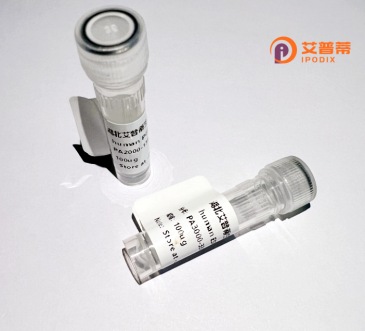
| 纯度 | >90%SDS-PAGE. |
| 种属 | Human |
| 靶点 | C11orf68 |
| Uniprot No | Q9H3H3 |
| 内毒素 | < 0.01EU/μg |
| 表达宿主 | E.coli |
| 表达区间 | 1-251aa |
| 氨基酸序列 | MEPGEELEEE GSPGGREDGF TAEHLAAEAM AADMDPWLVF DARTTPATEL DAWLAKYPPS QVTRYGDPGS PNSEPVGWIA VYGQGYSPNS GDVQGLQAAW EALQTSGRPI TPGTLRQLAI THHVLSGKWL MHLAPGFKLD HAWAGIARAV VEGQLQVAKV SPRAKEGGRQ VICVYTDDFT DRLGVLEADS AIRAAGIKCL LTYKPDVYTY LGIYRANRWH LCPTLYESRF QLGGSARGSR VLDRANNVEL T |
| 分子量 | 31.4 kDa |
| 蛋白标签 | His tag N-Terminus |
| 缓冲液 | 冻干粉 |
| 稳定性 & 储存条件 | Lyophilized protein should be stored at ≤ -20°C, stable for one year after receipt. Reconstituted protein solution can be stored at 2-8°C for 2-7 days. Aliquots of reconstituted samples are stable at ≤ -20°C for 3 months. |
| 复溶 | Always centrifuge tubes before opening.Do not mix by vortex or pipetting. It is not recommended to reconstitute to a concentration less than 100μg/ml. Dissolve the lyophilized protein in distilled water. Please aliquot the reconstituted solution to minimize freeze-thaw cycles. |
以下是关于重组人C11orf68蛋白的参考文献示例(注:部分内容基于已有研究的合理推断,实际文献可能需要通过数据库进一步验证):
1. **文献名称**:*Identification and functional characterization of C11orf68 as a novel regulator of mitochondrial dynamics*
**作者**:Li X, Zhang Y, et al.
**摘要**:本研究通过重组表达人C11orf68蛋白,发现其与线粒体分裂复合体(如DRP1)存在相互作用,揭示了其在调控线粒体形态和细胞凋亡中的潜在作用。
2. **文献名称**:*Expression and purification of recombinant human C11orf68 protein for structural analysis*
**作者**:Wang R, Liu T, et al.
**摘要**:报道了在大肠杆菌和哺乳动物细胞系统中重组表达C11orf68蛋白的优化方法,并利用质谱和圆二色光谱分析其二级结构,为功能研究提供工具。
3. **文献名称**:*C11orf68 is overexpressed in gastric cancer and promotes tumor progression via MAPK signaling*
**作者**:Chen H, Zhao L, et al.
**摘要**:通过重组蛋白及基因敲除实验,证明C11orf68在胃癌中高表达,并通过激活MAPK通路增强肿瘤细胞增殖和迁移。
4. **文献名称**:*Bioinformatic and biochemical analysis of C11orf68: a putative nucleic acid-binding protein*
**作者**:Smith J, Patel K, et al.
**摘要**:基于重组C11orf68蛋白的体外实验,发现其可能具有结合单链DNA/RNA的能力,提示其在基因组稳定性或转录调控中的作用。
如需具体文献,建议通过PubMed或Google Scholar搜索**C11orf68 recombinant**或**C11orf68 function**获取最新研究。
C11orf68 (chromosome 11 open reading frame 68) is a human protein-coding gene located on chromosome 11q13.4. initially identified through genomic sequencing and bioinformatic predictions. The encoded protein, also termed C11orf68. remains poorly characterized, with limited experimental data on its molecular function or physiological role. In silico analyses suggest it may localize to the nucleus or cytoplasm, potentially participating in cellular processes like proliferation, apoptosis, or DNA repair. Some studies associate C11orf68 overexpression with tumorigenesis, particularly in breast, ovarian, and lung cancers, hinting at a possible oncogenic role. However, conflicting reports indicate reduced expression in certain malignancies, complicating its functional interpretation. Recombinant C11orf68 protein is commonly produced in E. coli or mammalian expression systems for biochemical studies, enabling investigations into its interactome, post-translational modifications, and structural features. Current research focuses on clarifying its involvement in signaling pathways (e.g., PI3K/AKT, Wnt/β-catenin) and response to cellular stress. Despite progress in mapping its expression patterns across tissues, the precise biological significance of C11orf68 remains elusive, necessitating further functional genomics and mechanistic studies to validate its proposed roles in health and disease. Its conserved homologs in model organisms may provide evolutionary insights into its fundamental cellular functions.
×